Wild Strawberries. Unmasking the magic of these tiny treasures.
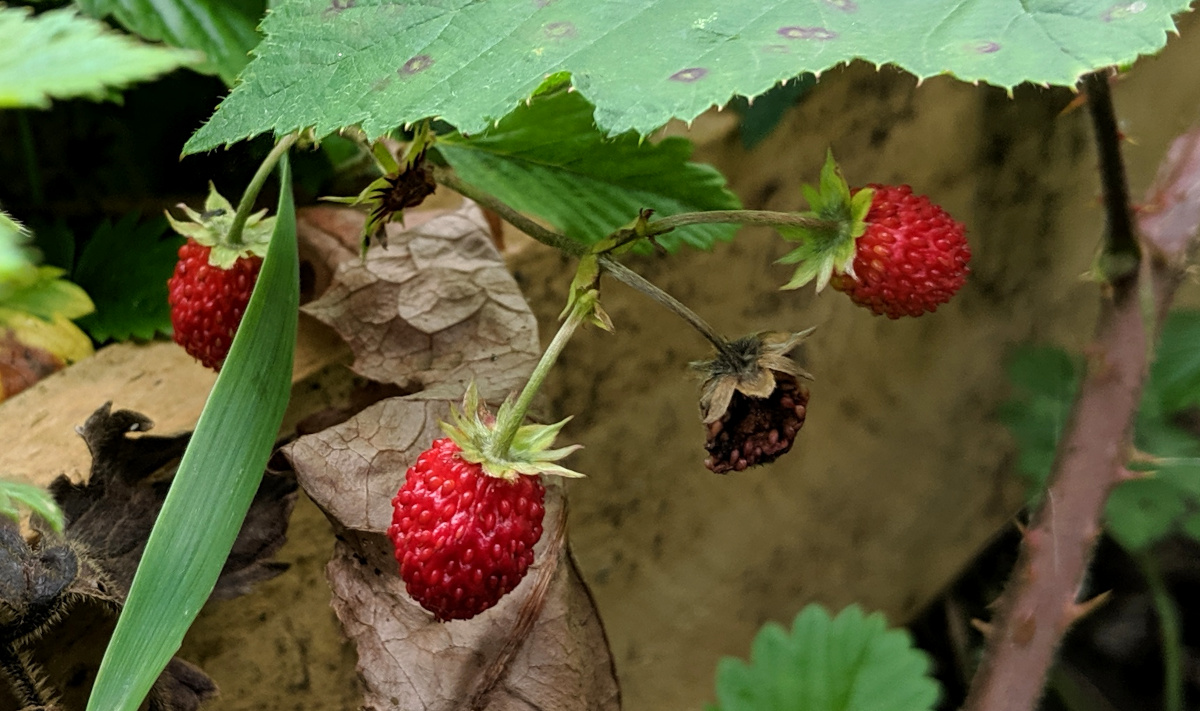
Wild strawberries are a delightful departure from their cultivated counterparts. They are relatively rare in the wild thanks to habitat loss but are easy to cultivate.
Table of Contents
How to identify the wild strawberry:
The wild strawberry looks like a smaller version of the cultivated ones.
Leaves:
- Trifoliate: Look for three leaflets radiating from a central point.
- Glossy and wrinkled: The leaves are shiny on top and have a slightly puckered texture.
- Serrated edges: The leaflets have tiny teeth along their margins, like a mini saw.
- Hairy undersides: Flip the leaf over – the underside should be lightly covered with fine hairs.
Below: Wild strawberry identification. Notice the leaves, ripe and unripe fruit as well as the runner across the middle.
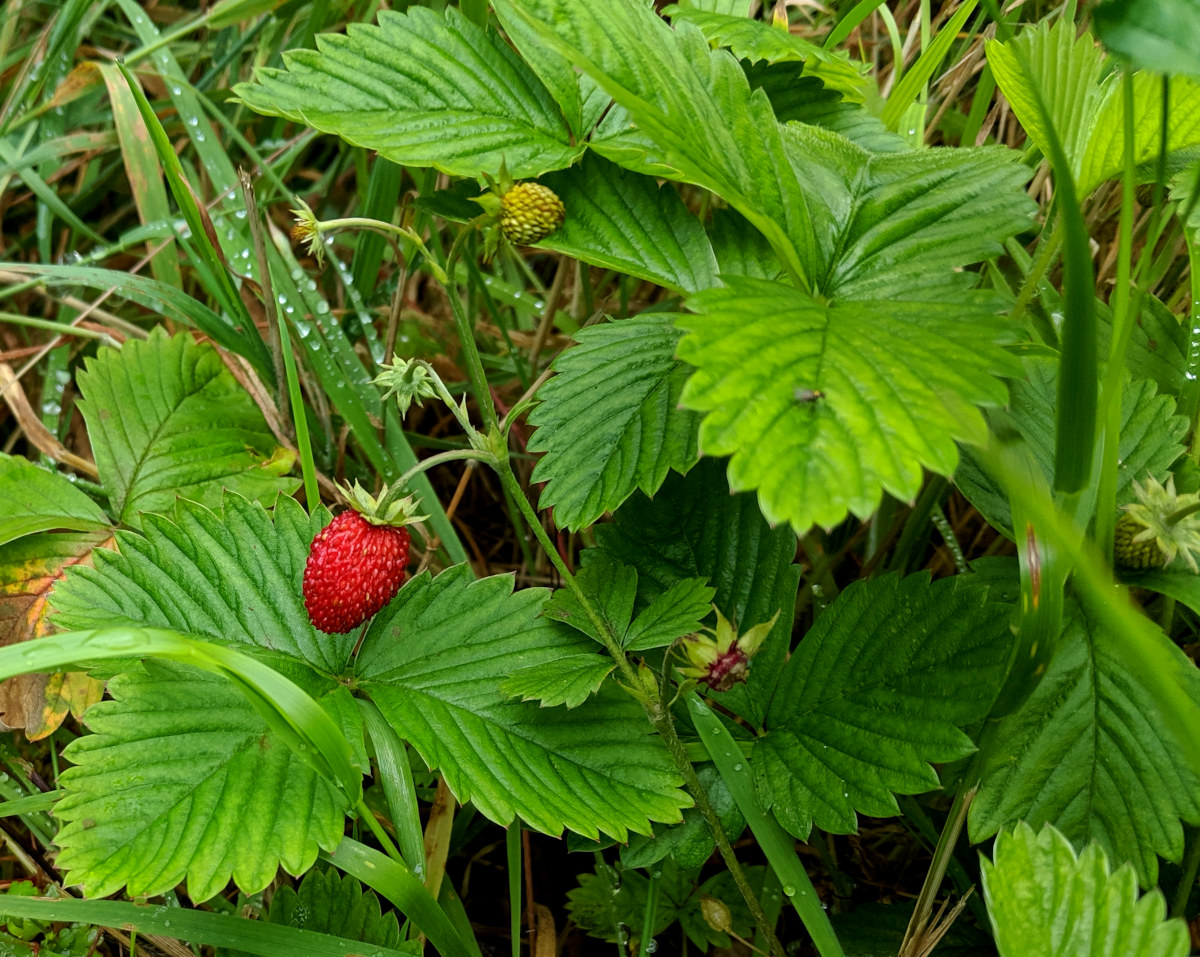
Flowers:
- White and delicate: Imagine tiny porcelain bells with five white petals and a yellow centre.
- Look like a tiny rose. The strawberry is a member of the rose family of plants.
- Clustered on stalks: These little blooms don't show off alone; they often appear in groups on hairy stalks rising above the leaves.
Below: The flowers of the wild strawberry.
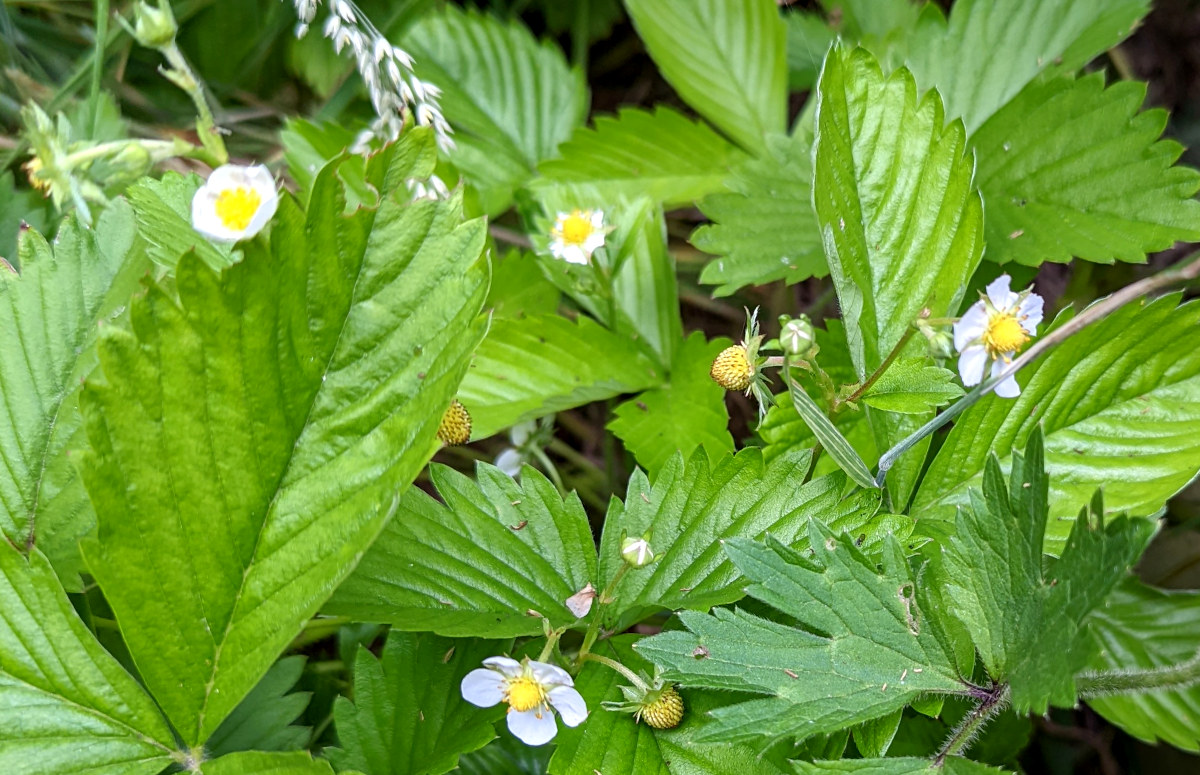
Fruit:
- Tiny and heart-shaped: Think ruby raindrops, not supermarket giants. These berries are small and have a distinctive heart-shaped form.
- Deep red and shiny: Ripe berries boast a rich, almost crimson colour, with a glossy sheen that invites picking.
- Achingly sweet: Don't judge a berry by its size! Wild strawberries pack a punch of intense sweetness, often with a hint of tartness, far exceeding their cultivated cousins.
- Seeds on the outside: Unlike garden strawberries, the tiny seeds are nestled directly on the surface of the fruit, like sprinkles on a cupcake and are more noticeable on the wild type.
Below: The fantastic little fruits of the wild strawberry.
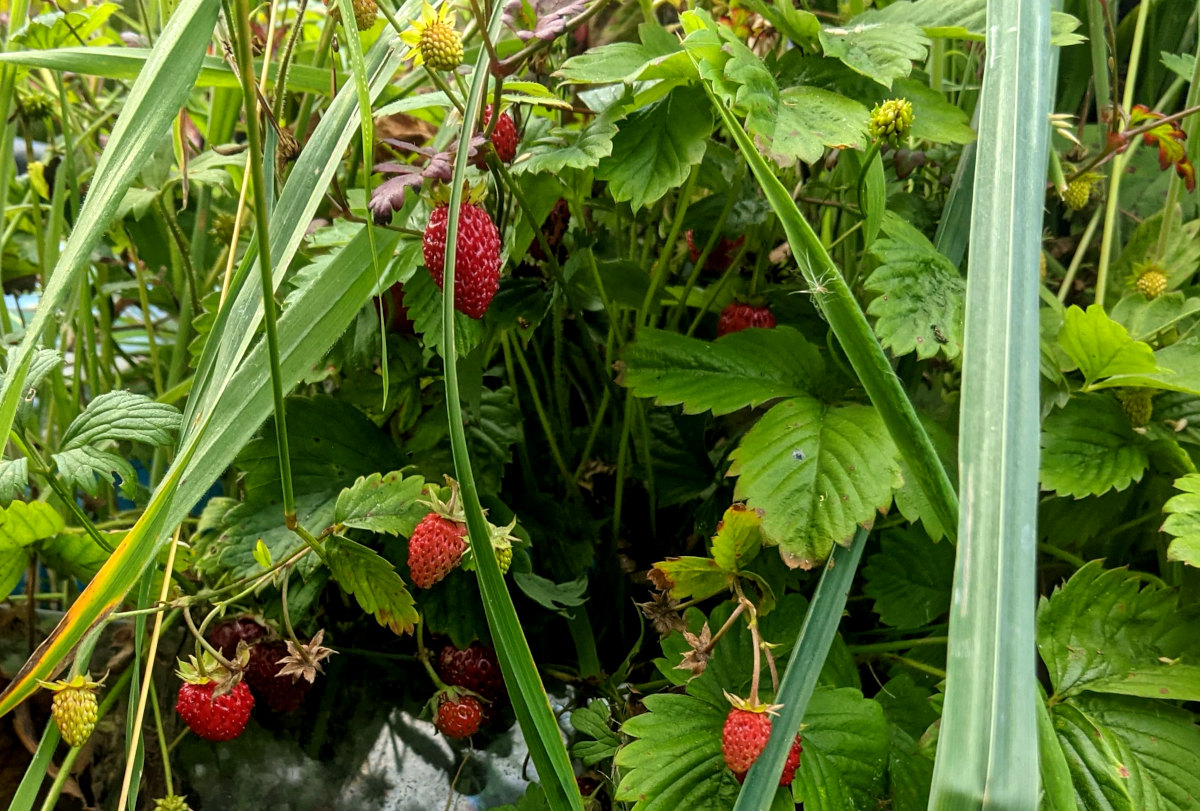
Everything you ever wanted to know about wild strawberries:
They are found in the wild across northern Europe and have been introduced into many other parts of the world. In the wild they tend to be found at higher altitude and prefer cool, well drained and lime rich stony soils.
The difference between a wild strawberry and a regular strawberry is more than size.
Below: Wild strawberries are small and found in small clusters making it difficult to collect a substantial quantity.
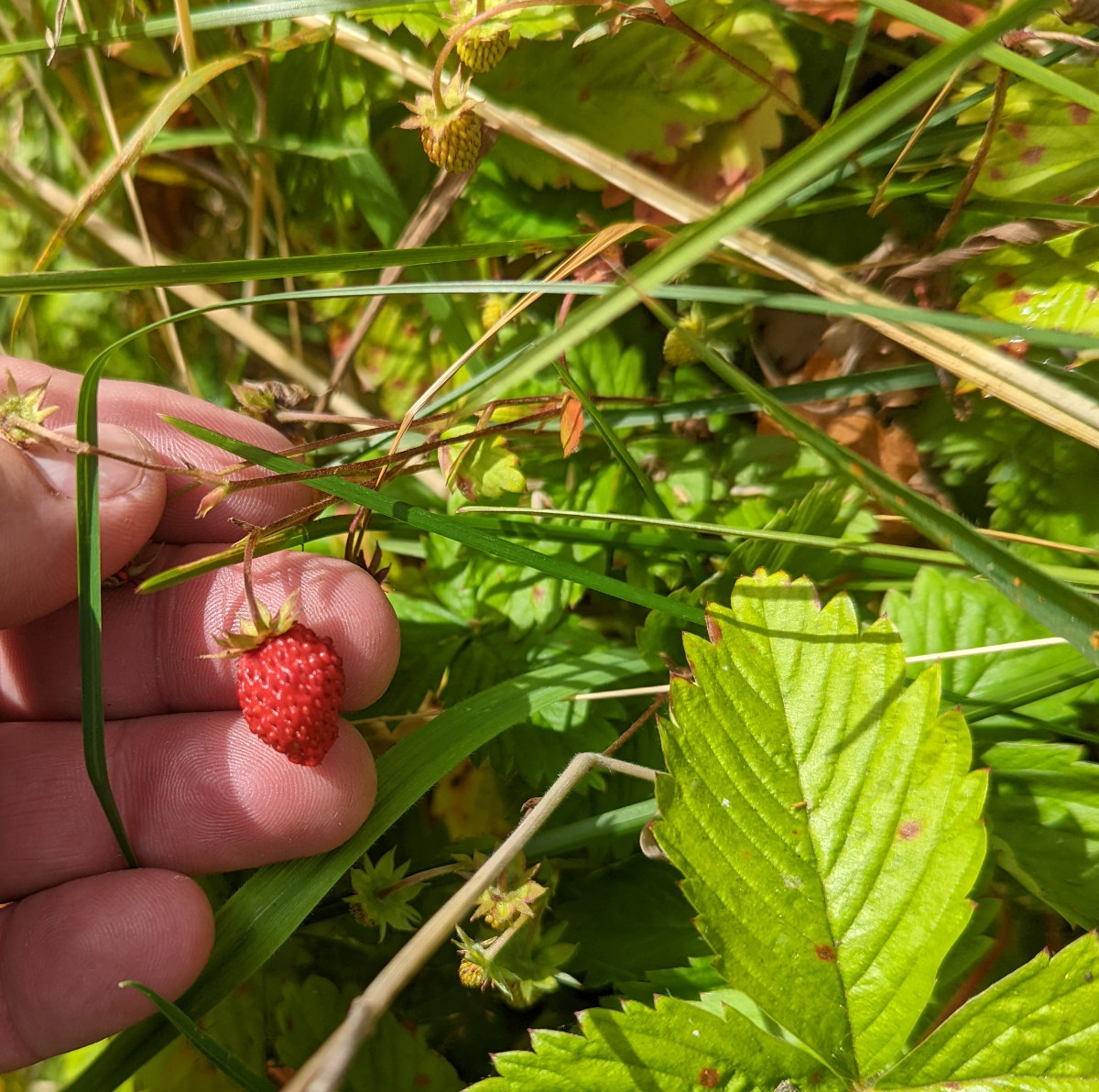
The flavour of the wild strawberry is deeper and sharper with a greater lingering acidity. Almost as if the flavour from 3 or 4 shop bough berries has been compressed into one small one.
Wild strawberries also have a longer fruiting period, often producing smaller numbers over the whole of summer and even into the Autumn.
Their diminutive size is no indication of a lack of flavour – quite the opposite, as their small stature concentrates their taste into a burst of strawberry bliss.
Where to find wild strawberries:
Wild strawberries are not grown commercially or available in the shops because of their small size and tiny yield. If you want to taste these amazing little fruits you will need to forage them or grow them yourself.
Also referred to as woodland strawberries, alpine strawberries, or fraises des bois, these gems are renowned for their intense sweetness and aromatic profile.
- Alpine strawberries: Similar in size and sweetness, but with a slightly musky flavour.
- Woodland strawberries: Slightly larger than wild strawberries, with a milder taste.
The wild strawberry is often found in undisturbed wildflower meadows and occasionally in older hedgerows. Here in Yorkshire I am very lucky that we have several reserves and protected areas where they flourish.
Below: Wild strawberries in a Yorkshire meadow.
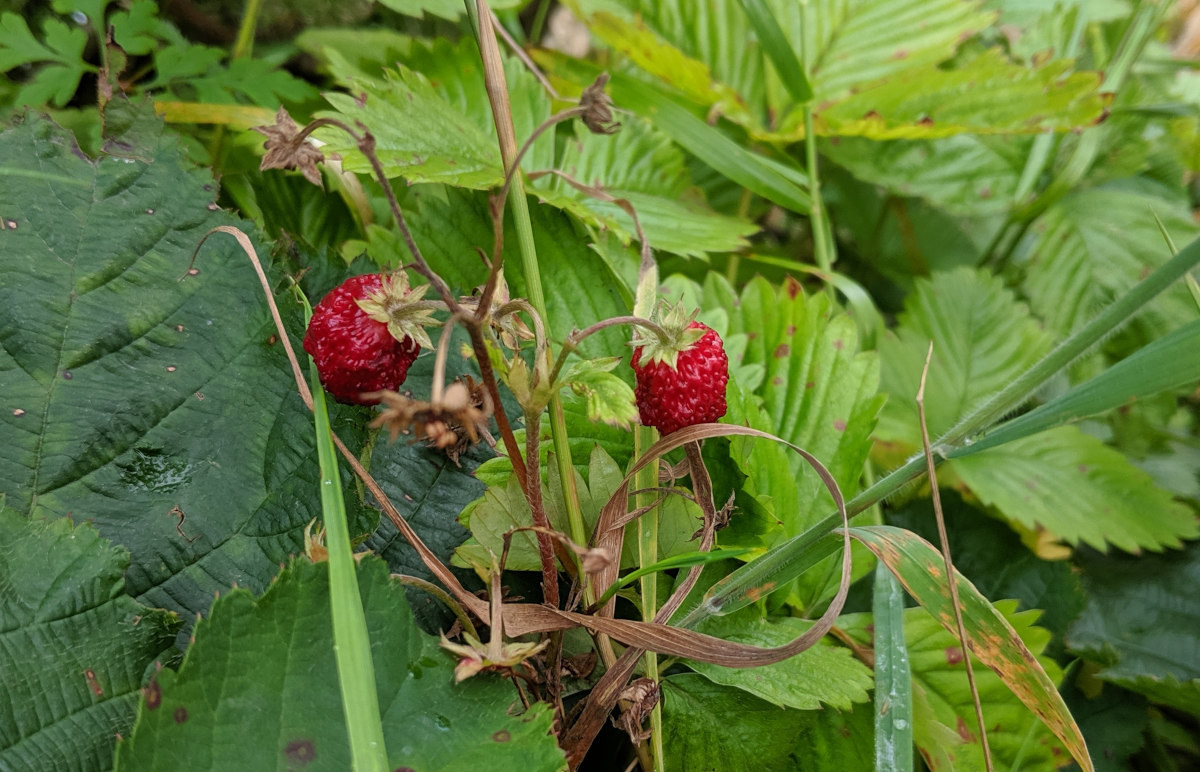
Forget your plump supermarket giants, these are nature's bonbons, bursting with a sun-kissed sweetness that'll knock your socks off.
Things to make or do with wild strawberries:
You should always wash wild strawberries before use. Clean and prepare them in the same way as store bought berries and remove the green calyx at the top of the fruit.
Here is some of the things you can do with wild strawberries:
- Jam: This is a classic for a reason! Wild strawberry jam is bursting with concentrated flavour and makes a wonderful spread for toast, scones, or even ice cream.
- Plain: Eat them with some whipped or clotted cream
- Ice cream: Wild strawberries add a unique and intense flavour to homemade ice cream. You can use them whole, mashed, or infused into the cream base.
- Pie: A rustic wild strawberry pie is a beautiful way to showcase the fruits. Use a simple crust and let the berries be the star.
- Drying: Wild strawberries can be dried and added to breakfast.
- Steeping: Add wild strawberries to clear alcohol and allow to infuse for up to 6 months, serve over ice with soda in summer months.
- Clafoutis: This baked French dessert is like a pancake filled with juicy fruit. It's perfect for a summer brunch.
- Compote: A quick and easy way to use up a small batch of strawberries. Serve it warm over yogurt, pancakes, or waffles.
- Steak: Wild strawberries with a ribeye and black pepper.
- Salad: Toss in a handful of wild strawberries to add sweetness and a pop of colour to your salad. They pair well with greens, goat cheese, and balsamic vinaigrette.
- Salsa: Wild strawberries add a touch of sweetness and acidity to salsa. Try them with tomatoes, avocado, and cilantro.
- Vinegar: Infuse white wine vinegar with wild strawberries for a unique flavoured vinegar to use in salad dressings or marinades.
- Syrup: Drizzle syrup made with wild strawberries over savoury dishes like chicken or pork for a sweet and unexpected twist.
- Preserves: If you want to save your wild strawberries for later, you can preserve them in syrup or make a liqueur.
- Decoration: Use whole wild strawberries to decorate cakes, cupcakes, or other desserts.
The strawberry is a member of the rose family and the name ‘strawberry’ is thought to have come from "streabariye" - a word used by a Benedictine monk in AD 995 to describe how the plant spreads through runners.
Here's how to cultivate wild strawberries at home:
With a little love and attention, your backyard can become a haven for these tiny treasures, rewarding you with a taste of the wilderness right at your fingertips.
Choose your position for planting and prepare the soil:
- Sunshine: They crave at least 4-6 hours of sunlight daily, but appreciate dappled shade during the hottest part of the day.
- Soil: Aim for well-draining, loamy soil rich in organic matter. A slightly acidic pH (around 6.0-6.5) is ideal.
- Location: Consider raised beds or containers if your soil is heavy or needs amendments. Edges of sunny borders, beneath fruit trees, or along pathways are perfect spots.
Planting options:
- Seeds: Start indoors in late winter, using a light, sandy potting mix. Keep seeds lightly covered and exposed to light. Once seedlings have four leaves, harden them off before transplanting outdoors in spring.
- Plants: Look for bare-root plants or runners from reputable nurseries in spring or early fall. Plant shallowly, with the crown at soil level.
- Runners: These natural extensions from established plants are the easiest way to propagate. Simply detach them from the mother plant and bury them shallowly in your chosen spot.
Cultivating with care:
- Watering: Keep the soil consistently moist, especially during hot spells. Mulch with straw or wood chips to retain moisture and suppress weeds.
- Feeding: A light application of compost or organic fertiliser once in spring and again after harvest is enough. Avoid overfeeding, as it can encourage leaf growth over fruit production.
- Weeding: Be gentle, as wild strawberries have shallow roots. Hand-pulling weeds is your best bet.
- Harvesting: Patience is key! Your first berries may appear in late spring or early summer. Harvest gently when fully ripe, usually a deep red with a slight give.
Bonus tips for successful wild strawberry harvests:
Attract pollinators like butterflies and bees by planting herbs and companion flowers like borage or alyssum near your patch.
Protect your berries from birds and other critters with netting or row covers.
Let some runners grow to create a natural ground cover or to propagate new plants. I now have several patches where wild strawberries have formed a carpet that covers the earth.
And don't forget, these mini marvels thrive in containers too! So, even if you're short on space, you can still savour the taste of the wild. Just choose a well-draining pot and provide plenty of sunshine and TLC.
